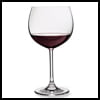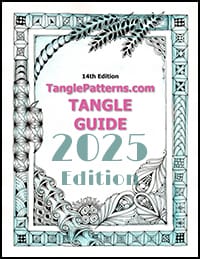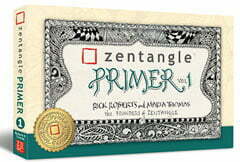 “Are they only done on a 3 1/2 inch square?” New reader, DeJa, asks this question about Zentangle®, and it’s an interesting enough inquiry that I wanted to respond in a post for discussion. Since I’m not a CZT nor affiliated with Zentangle® in any way, this is entirely my point of view. (NOTE: this was published in October 2010. In October 2011 I attended the CZT7 seminar and the content of this post is congruent with the CZT training.)
“Are they only done on a 3 1/2 inch square?” New reader, DeJa, asks this question about Zentangle®, and it’s an interesting enough inquiry that I wanted to respond in a post for discussion. Since I’m not a CZT nor affiliated with Zentangle® in any way, this is entirely my point of view. (NOTE: this was published in October 2010. In October 2011 I attended the CZT7 seminar and the content of this post is congruent with the CZT training.)
I think it’s important to stick to the originators’ guidelines when you are first starting out and learning about Zentangle®. The small format accomplishes several things. Firstly, it allows those who “don’t think they can draw” to see fantastic, immediate results and this enhances one’s confidence. On their Theory of Zentangle page, Rick and Maria write:
A Zentangle tile is 3 1/2 inches square (which, with respect to Fibonacci proportions, is equivalent to 89 millimeters or 21 picas). Zentangle is designed to be completed in one sitting. You can finish one in about 15 minutes. You get an immediate sense of accomplishment by completing your work of art in increments.
Possibly as important as this “immediate sense of accomplishment”, the small format develops and hones the fine motor skills that make your art better and better over time. (You only have to take a few days break from drawing to see that practice is important to keeping those fine motor skills honed.) Drawing in this small format demands that one really focus, make deliberate strokes, and follow each pen stroke — leading to the shift of attention and meditative state that follows.
Once you have experienced Zentangle as it is intended and developed your own experience, I think it inevitable one becomes intrigued with ideas of moving on to larger formats and various media. This is known as Zentangle-inspired art. Many use larger paper and journal formats, add color, and use lots of different physical items (“supports” in artist-speak) like gourds, and even tennis shoes. Have a look at Cookie’s great T-shirt here. Some have also created Zentangle designs in fiber arts, wood burning, metal work, jewelery, and more.
For myself, in terms of aesthetics I still favor the small, original format and intricate design with its scale of pattern size. That miniature piece of art is a universe all its own that larger formats and bigger scale patterns just can’t compete with. Sometimes larger pieces suffer from pattern overdose, in my view.
What are your thoughts on this subject? Agree, disagree, whatever. Let’s hear it! Over to you …
BTW – If you haven’t actually read Rick and Maria’s Theory of Zentangle page yet, please do. You will better understand why Zentangle has been designed the way it is and what you can expect to get out of it. And if you are going to call your creations Zentangle, it’s useful to understand the basics from “the source”.
|
.oOo. |
|
Enhance your Zentangle experience while supporting TanglePatterns: |
|
CURRENT EDITION! TanglePatterns.com TANGLE GUIDE, 2025 Edition |
|
 |
The 14th Edition of the TanglePatterns.com TANGLE GUIDE is an instant-download 117-page interactive digital eBook/PDF containing over 2,000 tangles on the site from May 2010 through December 31, 2024. It's a great resource and a must-have digital tool for using the site. Visit the STORE > E-BOOKS page and help keep TanglePatterns.com going by getting your copy now! |
|
"Linda, Thank you! I was relying on too few and getting stuck after 3 years of daily working with Zentangle. This has inspired me to ‘begin again’ with renewed excitement." ~ Barbara R. |
|
| See the BOOK REVIEWS page for more details on its features and view a sample page. Note: this is a digital product you download immediately when you place your order, nothing will be physically mailed to you. | |
| If you're new to Zentangle® and tangling, my TanglePatterns.com BEGINNER'S GUIDE TO ZENTANGLE is just what you need to get started. Also available en Français and en Español. | |
|
|
|
 |
This is the only Zentangle book you'll ever need: the fabulous Zentangle PRIMER Vol 1. It's your CZT-in-a-book by the founders of Zentangle®. Visit the STORE tab on the top menu bar or click on the image. For more about the content and to read the rave reviews, visit the BOOK REVIEWS tab. |
| Now available in KINDLE format for $9.99. Spanish Edition here. Japanese Edition here. | |
| "Absolutely the best Zentangle Book yet! As an accomplished artist I used to think I did not need instruction on this art form. How wrong I was! My tangling improved by leaps and bounds after reading this book. If you think you have Zentangle down then you need this book more than ever!" ~ Kris H | |
|
|
|
|
.oOo. |
|








According to CZT (certified Zentangle Teacher) training, a Zentangle is the form created on a 3.5 in tile, with patterns referred to as tangles. Works using these pattern but differing in size and shape and surface are ‘Zentangle inspired Art’.
There is a lot of beautiful art work out there using these patterns as their palette. Creativity abounds, and we are fortunate to be able to access so much through the web.
Hope this helps. NancyL CZT
Thanks for your input Nancy. Much appreciated!
I too understand and appreciate the reasoning behind the 3.5 in. tile. But I have found myself inspired on many occasions where I did not have one and have used whatever I could get my hands on. (i.e. the carry out menu of my favorite deli) Granted these may not make a “wall worthy” piece of art but the stress relief of the exercise itself was great. I hope this helps.
I experimented with using larger pieces of paper and went back to the classic 3 1/2″ square. I found that working larger emphasized the product and what captivates me is the process. I love the peaceful mood I get from zentangling.
Thanx for the conversation.
Excellent comments, Joan. Thanks for contributing to the dialogue.
I feel the same way, Joan.
Recovered comment that was accidentally deleted:
6/4/2014
Jan Brandt, CZT – So well said, Joan! Now I know why I always gravitate back to the Zentangle tiles after spending days on a larger piece.
I have done the classic Zentangle™ squares and Zentangle™ inspired art as well. If you love the 3 1/2 inch size save your favorites and you can frame a group…nine or twelve or more to have a larger piece of art.
Great advice
I like the 3 1/2″ x 3 1/2″ tile for creating Zentangles. I also like rubber stamp impressions that are of an “outline” nature. The imagine can be enlarged or made smaller on a copier. How about alphabet stencils? Put one large letter, with Zentangles patterns inside, on an envelope. Use the letter representing the name of the recipient. Other stencil outlines can be used like a bird, a flower, a heart, etc. Also, I’ve enjoyed creating a Zentangle Sampler. These are some of the joys I’ve had while doing Zentangles.
I find this question most interesting. By trade, meaning employment, I have worked as a mechanical designer/draftsperson. I have been technically formatted to do drawings , according to scale. I think whatever makes one comfortable, works. 1:1. Can easily formatted to whatever scale that one wants one’s artwork to be viewed. If small makes you feel you comfie, go with it…If large scale (murals, etc), go with it. Create, with what enables, yourself, to project your image and convey what you are you are trying to convey.
Just have fun and go with the flow. Life already has too many constraints. Artwork is, such a great gift. It allows an individual a voice, without word’s. An expression, without a face. A sound, with no reverberations. A gift, beyond grace. A great means to communicate, with no limitations or expectations.
Fifteen minutes? REALLY??? I have yet to finish one that fast, no matter the size.
I was going to say the same thing…the first few I did (just recently) took me several hours; granted I was still getting used to the pattersn, and trying to use specific patterns in the work, maybe that’s why it took so long. Ic an see how a seasoned tangler could finish one quickly; I guess i’ll just have to work up to it! 😉
There’s a difference between process and product. The process of creating a zentangle, mindfully, creatively, for thousands of reasons, offers many benefits. It is the process that draws me to the form.
The “official” product, a 3.5 x 3.5 inch tile is a great way to start the journey of creativity, inspiration, and stress relief. But in this world of ours, where one thing leads to another, the natural course is to begin to make it your own, watching the patterns morph into unique combinations, and spilling over into new areas, like shoes, mugs, t-shirts, quilts, walls, etc. That is the beauty of zentangles….there is no limit to creativity and joy.
What a beautiful statement!! Spilling over is definitely right!
Zentangle, by definition, is 3 1/2″ square, non-directional, and non-representational. But Zentangle Inspired Art can be so many things!!
I don’t want to say “more,” because the art form and process is perfect in and of itself, to my mind.
But expanding into other sizes, surfaces, media, is also awesome! It just depends on you, your muse, and where you want to go!
I agree wholeheartedly with Marguerite – do whatever is comfortable! Life is too short to “draw within the lines”. I have tried both big and small, and definitely like the small better. I use a 5.5 x 8.5″ sketchbook for my drawings. Draw a line down the middle of the page at 4.15″ and I’ve got room for 2 tangles/page. Perfect for me. However, if I like a design that’s bigger, I certainly won’t hesitate to use it.
I often use free coloring book pages I find on the web, which vary in size. For instance, I was looking for a Christmas tree, so I Googled “simple christmas tree coloring page”, clicked on “images” and there are hundreds to choose from :-).
Oh, and Micron the Cat – Amen, sister. I have a hard enough time finishing a tangle in an hour, let alone 15 minutes. Shoot, it sometimes takes me 15 minutes just to pick out a design to use in one little section!!
What a great idea, using coloring book pages, either from the web or leftover from my daughter’s coloring books. I’ll have to give that a try! I do enjoy drawing, but having a ready-made drawing to fill in with tangles would make a quick project too.
Thanks SO much for all the great dialogue.
I hope y’all (I do live in Florida after all) are having as much fun contributing as I am taking it all in.
I think you would all enjoy reading CZT Carole Ohl’s thoughtful take on this subject …
http://openseedarts.blogspot.com/2010/10/tools-not-rules.html
Carole says so much more gracefully than I – that the “rules” provide the structure and the tools. And from there we all take flight.
The net out of what I was attempting to convey is that to get the utmost out of it, you would SO be missing out if you didn’t check out what that Zentangle structure is.
Thanks for posting my question Linda. The conversation has been interesting. Ironically, the formats that I initially saw that were NOT 3 1/2 by 3 1/2 were on the zentangle site. They included clothing and decor items. I am even thinking about eventually doing a table top. But that will come later.
I have only been doing this for a week … craft addictions happen quickly for me (LOL). I love making things. The outcome of zentangles (I have done 3. The starter tile I got in my mini session was 6 x 6 and I played with it for about 6 days.) are amazing because you can’t preplan to some extent … at least I haven’t to date. However, I am sure that will change as I really learn what I am doing. I love using this site to learn new designs.
Thanks again
I read Carole’s post, Linda, and liked what I read. It’s always good to understand the structure of a technique before branching out and trying it your own way. Even if you only draw one tangle the Zentangle way and then do it your own, you’ve learned the correct technique. You can then make it your own.
That’s why tangles can look so completely different – they learned one way, then put their own spin on it. Everyone has their own style!
I truly believe we can apply this (Zentangle) philosophy to all aspects of our life’s. The essence of Zentangling is our expression’s to communicate and convey these feelings, beliefs through our Artwork. Let’s pass this on. Zentangles provide what we see, perceive and a great means to let other’s here our voice’s and heart’s.
I remember seeing a Zentangle on the web, finding the official site, ordering (and impatiently waiting) for the kit and trying it out. I think I made five tiles with the kit, but then I branched out.
I always carry a notebook with me. I write poetry in it, I sketch in it, I paste and color stuff in it. I especially love doodling with Zentangles in it. I might fill up a whole page, or insert some tangle in a margin. I’ve even tried to use them to make mandalas (my new fascination and obsession). I love them and I love discovering new patterns and ideas. (Thanks Cindi, I’m going to try out the coloring book idea. It sounds awesome!)
i do appreciate the traditional size of Zentangles, but I myself prefer to do mine on a larger scale because i get so engrossed in my work that if i do it so small scale i don’t keep working on a new tangle, but instead get distracted by life. But really its all preference. 🙂
Everyone is talking about creating Zentangles on a 3.5″ x 3.5″ tile or larger. How about going smaller? I just gave a Zentangle demonstration at the Ben Franklin Craft Store’s Holiday Open House here in Eugene, OR. I created tiles of 2″ x 2″ out of smooth Bristol, I put the names of patterns I used on the back and handed them out to customers. They loved them!
These are very popular with artists who create Artist Trading Cards, which are a strict 2.5″ x 3.5″ dimension. Very similar to the “official” tiles, but a rectangle instead of a square, and a tad smaller in one direction.
You have several links like this one:”If you haven’t actually read Rick and Maria’s Theory of Zentangle page yet, please do.” For me, at least, it’s a broken link. I found the material, thanks, but not by clicking your links.
Thought you might like to check them.
Thanks for the heads up. Zentangle just republished their site and the links have all changed. The Theory page is now here. And I’ve fixed the links above too.
I took a 3 hr lesson from a local CZT and worked on my tiles. Fun, Fun for sure then I took my Mom 76 to meet Maria. We bought Mom a kit, the big one and she had a blast but like me we were inspired to spread our new found love of this Zen Place we found ourselves in. We add it to cards, letters, walls etc. The day we met Maria fist thing I liked was her smile then HER SHOES! I guess my thought is as I Tangle my way through the rest of my life is that I will do so in PEACE and this art form gets me to that place in less than 15 mins. lol
I discovered zentangles when I read the article in Cloth Paper Scissors (my inspiration magazine). I have since expanded to zentangle inspired art, and now I am on another tangent – watercolor images inspired by the zentangle process. I retreat to “zentangle world” when my life gets to complicated, finding the joy in itty bitty designs. After being asked to elighten my artist group that meets every week for a “paint day” I discovered tangle patterns in the course of my research for handout materials. I am delighted to see so many artists who love zentangles.
I don’t think it has to be done on a 3 1/2 X 3 1/2 square, I prefer to do it in a small journal with really nice paper (that is pretty much like the square’s paper). I don’t understand why people say that’s not “Zentangle” if you do it on a larger canvas. You can still achieve the same peace as you get doing it on a smaller scale.Drawing can be done on any size canvas and it still called drawing, so is sketching, doodling, etc. So why not Zentangle. I think it’s all about the process and the calmness, doesn’t matter the size.
The squares that I now do my “daily” Zentangles on are 12cm square (about 5 inches). I did start on the small ones in my kit, but I found the size too cramped for me so I gradually got bigger until I was happy. I like to do several tangles on the one square and I find I am happier working on the same square for about an hour every single day. As I discovered Zentangle in February 2012, I have literally done hundreds. For me it is a definite form of meditation so whether I am working “tiny or tall” it has the same effect for me, so I agree with Kass, that no matter what the size, it is still the same process. Occasionally I try do zentangle on small pieces as little as 1, 2, or 3 inches square which I use on greeting cards, but to do the little ones, does not keep me meditating long enough, for me, so to end where I started, my daily meditative ones are on 12 cm squares.
The post by Eunice taking her mom & getting her started…I think my mom would to do this too. She is always talking about keeping calm and also keeping her mind active. Mom had arthritis in her hands, so here’s my question: Is there ‘something’ that can be put on the pens that might make it easier for somebody with bad arthritis to comfortably hold the pen? Anybody else come upon this problem?
*and if I posted this in the wrong place, apologies!
Hi Kathy
Try googling ‘pen grips’, or ‘writing aids for people with arthritis’. Hope you can find something there that will suit your Mum.
cheers
Ingrid
Recovered comment that was accidentally deleted:
6/14/2014
Sue Zanker – So interesting reading all these replies again! I started tangling on February 12th 2012 (it’s engraved on my forehead!!)
Now, over two years down the track, I find I definitely don’t “DO” tangling…….I “NEED” to tangle every day! My daily tangles are still on a ’tile’ measuring 12 cms square (4 & three quarter inches ‘ish) with roughly a 15mm (1 & a half inches’ish) margin leaving a ‘working’ square of 9cms (three and a half inches), so Zentangle’s official ‘size’ IS in there somewhere! To date I have done several ZIA on A4 and A3 sized paper using colour as well, which I really enjoy doing, but I STILL do my daily black and white Zentangle every day, which ALWAYS shifts my mind and soul into another level……..I could not do without Zentangle in my life now
After 2 years of practicing the Tangle Patterns I just can’t do them so small. By the time I get all the elements of just One Tangle on those small tiles, I have a black mushy mess. I don’t have hand problems, it’s the tile size. I do big ZIA’S (9 x 12), with lots of room for those finishing touches. I find the Micron .01 useful for only very fine accents. I do use a small artists sketch pad for developing my own Tangles. I tried using the Micron .01 and still found it too fine. Like using a thin mechanical pencil. It didn’t show up very well. I much prefer the .05. size tips. One can see “see” what one drew. So, from the beginning, I never relaxed when using the smaller. So, explain that conundrum. People like my ZIA’s.
as a person fairly new to Zentangle and looking at all the sites available on-line I found myself overwhelmed and feeling that “I could never do that” Not a place I wanted to be. One of the sites goes back to basics using the tile and choosing a different tangle each week. Let’s see what you can do with this… staying within the original concept of Zentangle. It was what I needed to stay on point and continue to believe that “I can do this” Now if I want to stray a bit with color I am not so uncertain but I am finding I enjoy the tile, my micron and pencil more..The old saying “More is not always better” seems to be where I need to be;
When I am making items for other people (eg greeting cards) I love to include one or more “Bijou” or smaller sized tiles as a form of decoration on the front and when I glue them on, I use rubber cement, so people can easily remove them and use them for something of their own. Everyone is different, (thank goodness!) so given freedom of choice, we can work on whichever sized tile works. Having said that, I use my black and white “daily” tiles solely as a calming, meditative action and even though I really enjoy working some ZIA on both larger and smaller tiles, I never get the same “feeling” as I do when I am working on my “daily”.
As long as I have an eye and a working hand, I will be tangling! By the way, I have just finished tangling my new white bicycle, it looks great!!
i’ve used tangle patterns as long arm quilting designs for several years. am currently take a leather working class. does anyone have any experience and/or suggestions on using these patterns on leather?
maggie